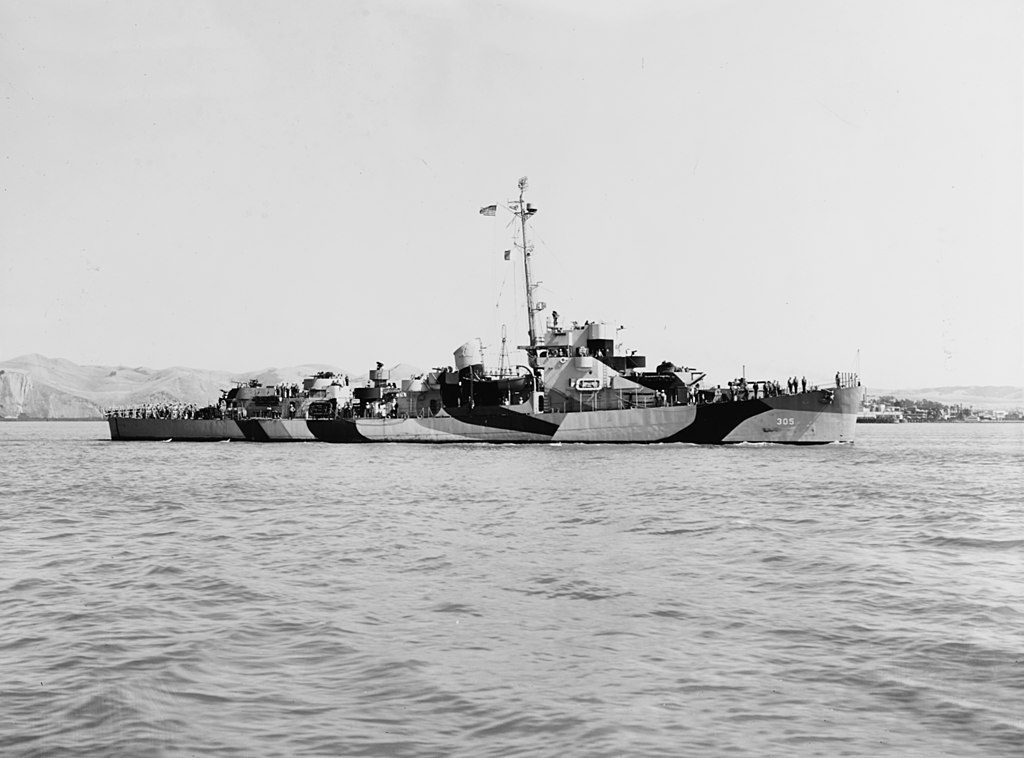File Photo: The U.S. Navy destroyer escort USS Halloran (DE-305) off the Mare Island Naval Shipyard, Califronia (USA), on 7 June 1944. U.S. Navy photo
By Michael Carr – At 23:00 on June 22nd, 1945, the general alarm bell was sounded onboard the USS Halloran, a 289 ft. United States Evarts class destroyer escort (DE). She was sailing escort duty near the Ie Shima Islands in the western Pacific Ocean, supporting the invasion of Okinawa Island, and had been under constant aerial attack for weeks.
When the general quarters alarm was sounded the radar plots in the ship’s communications center showed numerous air raids coming in from Japanese Kamikaze planes. At 23:47 the USS Halloran was attacked on her starboard quarter by an unidentified kamikaze. This plane could have been any one of various aircraft the Japanese had converted into “divine wind” flying bombs.
The night was overcast, and the plane was not spotted until within 200 yards of the ship. Flying at 150 mph it would cover this distance, and implode on the Halloran, in 2.4 seconds. Halloran’s gunners immediately opened fire with their 20mm anti-aircraft and 50 caliber machine guns. In response the Kamikaze, which had been intending to impact the Halloran undetected, began strafing the ship.
Bullets from the kamikaze impacted the Halloran from her stern to the bridge. When the plane was 15 yards, just 45 feet, from the ship a 50 caliber round, fired from the ship’s bridge gun station, impacted the kamikaze’s belly slung bomb and the plane exploded, less than half a second before it would have impacted the ship.
Some pieces of the plane landed in the water alongside the Halloran and others impacted the ship. Body parts from the pilot landed on the ships forecastle. Three of Halloran’s crew were killed, and a dozen injured. The ship was riddled throughout with holes of all sizes and shapes. Halloran’s bridge was torn apart, all communications, and the radar system were also destroyed.
Everyone remaining on the ship’s bridge were coated in oil and aviation fuel. The ship’s communications officer, who was on the bridge during the attack, wrote the following morning:
“The rest of the night was spent in confusion, and since the remaining part of this story is not pretty, and is no different than any other story of death, I’ll stop here.”
USS Halloran soon proceeded, under her own power, to the Kerama Islands, a group of Islands 20 miles SW of Okinawa, where she was repaired. Halloran and her crew then sailed for the Republic of the Philippines and participated in combat operations at Samar and Leyte Gulf. When the war in the Pacific ended on 15 August 1945, the USS Halloran sailed for San Diego, and then Charleston SC, where she was decommissioned in November 1945.
Ninety-seven Evarts class destroyer escorts (DE) were built during WW II and served in combat operations. These small, but able vessels, carried a crew of 156 officers and men. They sailed constantly, going from one mission and assignment to the next, executing with vigor every mission they were assigned, from active combat to supply runs.
All who sail the oceans, through long night watches, storms, gales, and calms carry the spirit and tenacity of those who have sailed before, whether it be those intrepid USS Halloran sailors, or on any of the many Naval, Coast Guard, Army or Merchant Marine vessels which have sailed, and are now sailing, the world’s oceans.
Every watch stood, with every navigation plot placed on a chart, every pot of black coffee brewed at 0400, and every log entry signed a solemn bond is made and kept with shipmates and fellow mariners. I reflect on the June night aboard the USS Halloran, and am hopeful all mariners have touchstones to the past, and a commitment to the future.

 Join The Club
Join The Club











